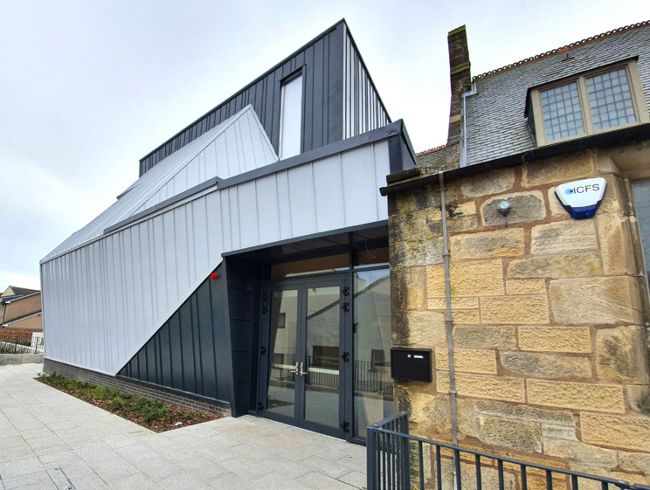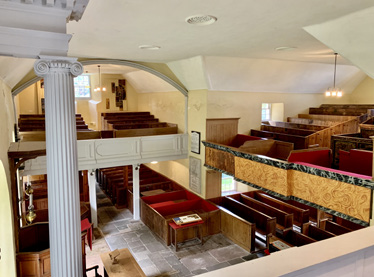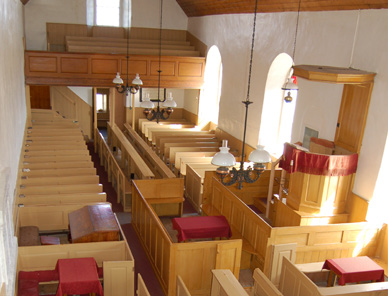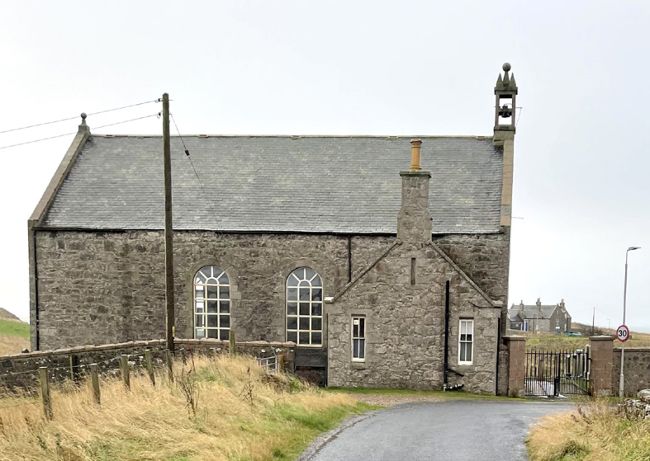New life from old stones
Church building closures have increased in recent years. Jackie Macadam considers the options for the future and shows how some have found a new purpose for communities.
COVER
THE church building can be a place of incredible significance and solace for many Christians.
The place you were baptised; the place you were married. The place where, perhaps, your children and grandchildren were christened.
But as the numbers of ministers fall, and congregations are united, linked or brought together, buildings are closed. Sometimes the buildings are beyond repair. Sometimes they are torn down and lost forever. Sometimes they are bought and become a restaurant or even a private home.
Kenneth McLean is a heritage professional and session clerk of Duns and District parishes in the Scottish Borders.
He is a big fan of church buildings.
“It says in Joshua 4: ‘Your children will ask you what are these stones? Tell them what they are’. I wonder what ours will ask about their built inheritance, and how we will respond?” he says.
“Although a younger churchgoer I’m an unashamed ‘churches romantic’. I cherish their architecture; their contribution to the landscape; their historical, spiritual, contemplative spaces. Each unique and rooted; each educational yet idiosyncratic. Each singly atmospheric! Falling congregations, rising costs and technological innovation threaten their survival – not new developments, but accelerated by the national emergency.
Scottish churches feel especially vulnerable. Unlike on the continent there are no state subsidies or taxes. Even in England, where the Churches Conservation Trust has a multi-million pound budget with contributions from DCMS (the Department for Digital, Culture, Media and Sport) and Church Commissioners, they are able to support nearly 400 churches whereas the Scottish equivalent, with no such funding, only has eight. Will interventions from the public, private or charitable sectors help these old stones endure?
“It may sound increasingly naive or unfashionable – but a perfect way to ‘save’ churches is their continued use by healthy worshipping communities. I wonder if we risk throwing out babies with bathwater in the drive for increased virtual worship.
Within my congregation ‘Zoom’ services were well-produced, well-received, and regarded as well-attended: but only about half who regularly came in person joined online. Upon reopening our physical attendances quickly approached old levels, despite ongoing restrictions; internet uptake dramatically declined. It remains unclear where the future pattern and emphasis will ultimately settle – but gathering together with one another proves enduringly popular.
“Undoubtedly our closure challenge differs from previous generations. Concern then focused on demolishing churches –
mostly unlisted and often regarded as ‘unworthy’ Victorian – and their consequent total loss as features in the built environment. Nowadays most are scheduled and obliteration relatively rare, though sadly still suffered by some charming post-war buildings (and at significant environmental cost in embodied carbon). What we face losing are not their exteriors as features to be passively observed, but their interiors as spaces to be actively experienced. Especially to private residential conversion.
“You hear of congregations setting their face against any alterations – pews, flooring, audio-visual equipment, community/leisure functions; only to close a decade later, with the building passing into secular use and the interior altering more radically than the resisted modernisation ever proposed. Equally there may be little sense producing copies and rivals of the nearby parish hall or community centre – ‘saving’ the church at the cost of its interior via diversification – rather than simply selling-up and relocating to that alternative facility.
“Just as it has for the last century, the Church of Scotland will be the principal contributor toward impending redundancy nationwide. However today we much more frequently mean historic parish churches: centuries in stone. With greater legal protection, older fabric and usually surrounded by graveyards, these are harder to adapt and often locally controversial to even sympathetic repurposing. Dereliction visualises decline. Public uses are popular – museums, galleries, hospitality venues, studios – but cannot absorb the numbers forecast, particularly in rural areas.

Former St Andrew’s Church, Lochgelly Photo credit: Fife Historic Buildings Trust

Cromarty East Church

St Peter’s Kirk
“Several old parish churches near me have been preserved by former worshippers. This shows benevolent care, endearing love – but does it only delay the inevitable a generation, and devolve it onto individuals? Perhaps we make too many assumptions. I met somebody ostensibly unreligious, nevertheless distressed by churches in their city becoming bars.
“I hope children will ask us “What are these stones?” – and that we can not only tell them what they once were, but show them what many remain.”
Ann Urwin and Colin Johnston, session clerk and senior elder for the Kilchrenan and Dalavich Churches, in Argyll, also feel strongly that more should, and could, be done to preserve old churches.
“For me, the reason for keeping old churches must depend firstly and most
importantly on the needs of their communities, secondly on the cost of maintenance of the buildings and thirdly on availability of financial assistance to ensure security for their future,” says Ann.
“An example of a rural parish is Kilchrenan and Dalavich which has a scattered population of approximately 250 people, on the shores of Loch Awe in Argyll.”
Each village has their own little church, both built in 1770 and “B” listed, with an old churchyard holding graves going back centuries and usually a more recent burial ground nearby which is in current use.
“Historically they are both important buildings,” says Colin. “We are told that long before there were roads, travel was mainly on water and Loch Awe was one of the main conduits for the spread of Christianity from the islands to the mainland. The settlements of Dalavich and Kilchrenan were convenient resting places for the missionaries to stop awhile and spread the Word.”
“It may sound increasingly naive or unfashionable – but a perfect way to ‘save’ churches is their continued use by healthy worshipping communities.
Ann adds: “It’s a wonderful testimony to Christianity that these churches give us. They are the recognised communal place of comfort for those with spiritual needs and an important point of contact. There has been a huge spiritual influence in the community in the past and it is still there today for those who wish to grab hold of it. It is available to everyone at anytime, anywhere and especially in the church buildings.”
“There is an expectancy within any community that the church will always be there for services of worship, for some people yes, but for most it is for weddings, christenings, funerals, religious festivals, dedications, other special celebrations and gatherings.” Colin adds. “However, these are all golden opportunities for God to reach out and touch His children. Times when the community meet together in their special place – their entitlement! They need them and if at all possible should not be deprived of them.”

Slains Kirk, Collieston Photo credit: Scottish Civic Trust (My Place Mentoring)
“The Church building in a small village is a focal point, a constant offer of hope and reminder of our spirituality which is irreplaceable.
“Ours is a relatively isolated parish with very little public transport and none on Sundays. “Even during this pandemic, when it was permissible and following Covid guidelines, the churches have offered an opportunity for prayer or a short service of worship.
“As to the future of the church buildings there have been many fundraising events and minor changes made to meet the demands of the time and to move forward into the future. Discussions are taking place constantly to determine the most suitable arrangements for services – timing, frequency and form, different types of services for different age groups and a ‘hymn sing’. The acoustics in each church are excellent for music appreciation and concerts but usage is restricted by no water supply. The churches are used within the scope of their environment. They are as ideal for quiet reflection in stunning, inspiring surroundings, or barbecues with sales stalls, treasure hunts for children and more.
“In big towns and cities there is normally a choice of churches to attend. Some churches have very high maintenance costs but with a larger population to support them, which might include skilled fundraisers, they can survive. In a rural area there is not the pool of people and funds are short and it may be the only church for miles. Closure of these churches would mean for some a thirty-mile round trip on a twisty minor road to attend a service and the elderly would find this extremely difficult.
“Preservation of these humble churches relies on good, annual maintenance and, apart from any major project, the expenses of such are usually just affordable.
Unfortunately, at this present time, to get building work done and quoted for, twice if applying for a grant, is an enormous problem for our property convener. Limited funds, complicated paperwork for grants etc, difficulty in getting quotes and last but not least, the uncertainty of a new Presbytery plan are determining their future. The community will always be there and so will their needs but will their churches? Their survival is an obstacle race. It would be interesting to contemplate what people in the future would make of the actions of this generation.
“The Church building in a small village is a focal point, a constant offer of hope and reminder of our spirituality which is irreplaceable.”
Victoria Collison is Executive Director of Historic Churches Scotland, formerly known as the Scottish Redundant Churches Trust. It’s a charity set up to protect and preserve the cultural heritage of old church buildings and also to support others, specifically communities, to achieve the same.
“Seeing the number of For Sale signs outside churches in Scotland’s towns and cities and throughout the countryside you could be forgiven for thinking that closure and reuse of these buildings is a modern phenomenon,” she said.
“In fact, there is a long tradition of repurposing in a country once reputed to have more pews than people. In the 1970s it was said that, since 1900, more Scottish churches had been abandoned, closed or demolished than were in use at that time. However, the majority of these were not lost but instead were adapted to other uses.
“For Historic Churches Scotland, a charity established in 1996 to safeguard nationally important churches where they are no longer required for regular worship, the reuse and adaptation of church buildings is a fundamental part of sustaining our built environment. The evolution of these buildings to serve new purposes can, and should, bring positive environmental, social and economic benefits.
“As in many other countries Scotland is experiencing widespread church closures. But can a look back over the last century offer insights to help decision-making now? Compared to some countries, Scotland’s approach to reuses has been pragmatic with churches becoming bars, restaurants, shops, galleries, theatres, warehouses, workshops, halls, a casino, and a garage. Whether such uses are ‘appropriate’ for former places of worship is highly subjective and does not sit easily with everyone. Residential use too can be contentious, both with a single house (often a smaller rural church) and multiple flats in larger urban churches. In addition to the loss of interiors and artefacts – inevitable casualties in any reuse – the ‘privatising’ of churches through residential use means the exclusion of people from a place holding individual and collective significance and memory.
For churches in graveyards (some still in use) the uneasy relationship of public and private space can be particularly challenging quite apart from practical difficulties installing power and drainage in archaeologically sensitive sites,” she said.
“The threat of loss, both in terms of a gathering space, and a community’s history over generations, has for many years prompted local people to take action and to buy their church when it closes, forming individual charitable trusts. Early examples at Crichton Collegiate Church and Nigg Old Church saw these buildings preserved intact and used for occasional worship, with numerous (particularly rural) communities following suit, responding to the closure of schools, shops, pubs and post offices by retaining their church.
More recently, and against the backdrop of a growing emphasis on community empowerment, increasing numbers of locally-led church trusts have been formed. Some, like Clova Kirk Trust and Glenisla Church SCIO, continue the preservation tradition of Crichton and Nigg Old, but others are sensitively adapting churches to meet the individual needs of their community. Kilmaronock Old Kirk Trust was formed in 2017 and successfully bought their B-listed church in 2021, together with its car park and glebe. The Trust aims to adapt the building as a cultural hub and social space for the community and to create a green burial ground in the adjacent glebe. In an ambitious project at Collieston, SEAchange (Slains Environmental Action for change) is developing a centre for climate change awareness in the former parish church of Slains, a project that also aims to support community cohesion and wellbeing. Also purchased in 2021 by a community-led trust is St Munn’s Church, Kilmun, on the shores of the Holy Loch. In addition to supporting a range of community activities, the church is a heritage hub for visitors and is working with others to develop the East Cowal Heritage Trail, growing the area’s valuable tourism economy. At the former St Andrew’s
Church in Lochgelly in Fife the construction of Fife Regional Climbing & Bouldering Centre, to be run by social enterprise Rockgelly, is well underway and is due to open in 2022. All across the country, the reuse of church buildings is delivering health, social and economic benefit to local communities and Scotland as a whole.
“While the vast majority of churches that close for worship can – given the right circumstances and support – be successfully, sympathetically and creatively reused, there remains a small but significant number that require a different approach. For some churches of particular architectural, historical or cultural importance, reuse is neither appropriate nor desirable. It was to act as a safety net for churches such as these that Historic Churches Scotland was established 25 years ago as the Scottish Redundant Churches Trust: safeguarding the most important churches for future generations in partnership with local communities.
The most recent church to come into the care of Historic Churches Scotland, St Peter’s Kirk, South Ronaldsay, Orkney, encapsulates the very type of church the charity was established to care for.
Acquired from the General Trustees of the Church of Scotland in October 2021, in partnership with the Friends of St Peter’s Kirk SCIO, this Category A-listed gem is a rare survival of a rural kirk dating from 1642 with an early 19th century central communion pew – one of only a few remaining in Scotland.
“The closure of churches can bring loss and sadness to individuals and communities but, managed in an informed and sympathetic way, and with the right framework in place, the reuse of these buildings can also bring new opportunities and purpose, ensuring that they continue to play a beneficial role long into the future.”